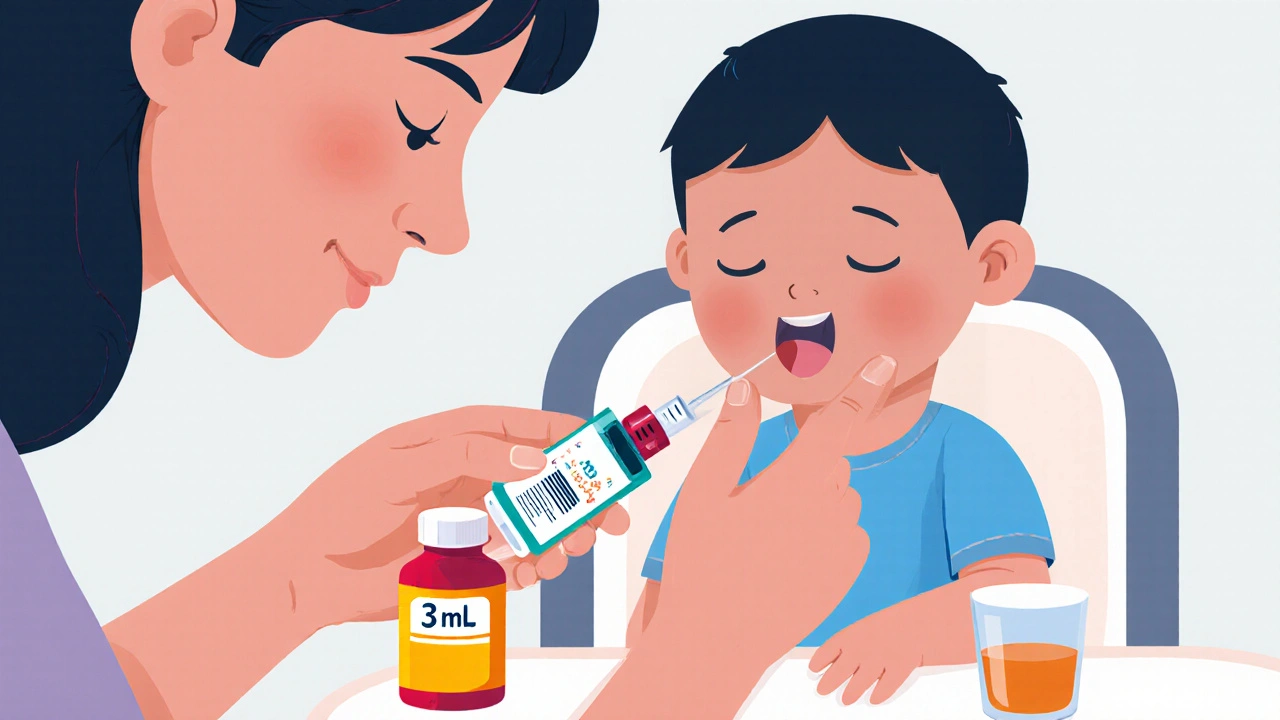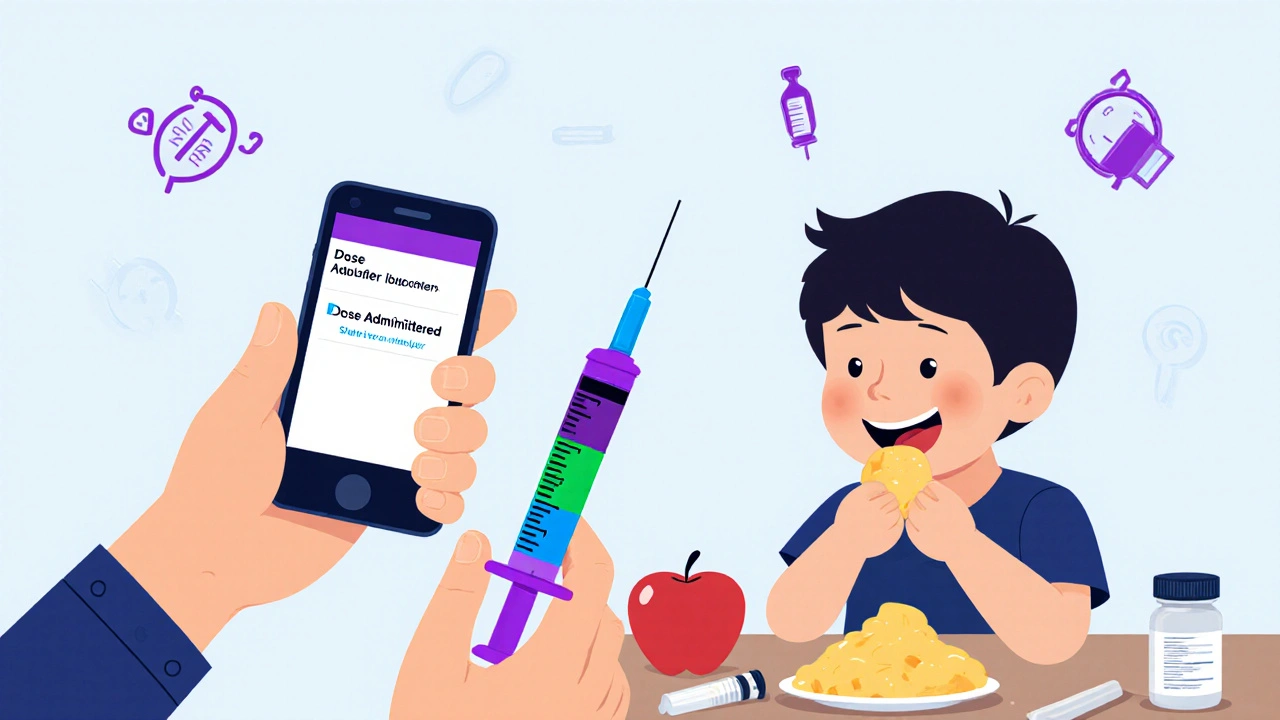How to Use Dosing Syringes and Oral Dispensers for Kids’ Medicines Accurately and Safely
 Nov, 24 2025
Nov, 24 2025
Giving liquid medicine to a child isn’t as simple as pouring it into a spoon. One wrong milliliter can mean the difference between relief and harm. Every year, thousands of children are rushed to emergency rooms because of dosing mistakes - not because parents are careless, but because they’re using the wrong tools or measuring incorrectly. The good news? Using a dosing syringe the right way cuts those errors by more than 80%. And it’s easier than you think.
Why Dosing Syringes Are the Only Safe Choice for Kids
Kitchen spoons, medicine cups, and even the little plastic spoons that come with the bottle? They’re not accurate. A standard teaspoon can hold anywhere from 2.5 to 10 milliliters - that’s a 400% variation. One parent might give 5 mL thinking it’s a teaspoon, while another gives 8 mL with the same spoon. For a child weighing 12 kilograms, that’s a 60% overdose of acetaminophen. That’s dangerous. Oral syringes are designed for one thing: precision. They’re marked in milliliters (mL), not teaspoons or tablespoons. The FDA banned teaspoon measurements on pediatric prescriptions in 2018 because they caused 20% of all dosing errors. Today, every prescription liquid medicine must come with metric-only instructions - and an oral syringe. Studies show that when parents use oral syringes correctly, dosing errors drop from 40% to just 8%. That’s not a small improvement - it’s life-changing. The American Academy of Pediatrics (AAP) says oral syringes are the gold standard for infants and toddlers. Even for older kids, they’re the safest bet for doses under 5 mL.Choosing the Right Syringe Size
Not all oral syringes are the same. They come in four standard sizes, each with different markings for maximum accuracy:- 1 mL syringe: Best for doses under 1 mL. Marked in 0.01 mL increments. Used for very small babies or concentrated medications.
- 3 mL syringe: Ideal for doses between 1-3 mL. Marked in 0.1 mL increments. This is the most common size for toddlers on antibiotics or fever reducers.
- 5 mL syringe: For doses between 3-5 mL. Marked in 0.2 mL increments. Good for older toddlers and preschoolers.
- 10 mL syringe: For doses over 5 mL. Marked in 0.5 mL increments. Used for larger volumes, like some antihistamines or anti-nausea meds.
Never use a 10 mL syringe to give 1.5 mL. The markings are too far apart. You’ll guess - and guess wrong. Always match the syringe size to the dose. If the pharmacist gives you a 10 mL syringe for a 2 mL dose, ask for a 3 mL one. They’re usually free with prescriptions.
How to Draw the Correct Dose
Follow these steps every single time - no shortcuts:- Shake the bottle for 10-15 seconds. Many liquid meds are suspensions - the medicine settles at the bottom. If you don’t shake, you’ll give mostly water.
- Remove the cap and insert the syringe tip into the bottle. Don’t force it. If it’s hard to insert, the bottle might be too full. Pour a little out first.
- Turn the bottle upside down and slowly pull the plunger back until the top edge of the rubber stopper lines up with your dose mark. Don’t eyeball it. Look straight at the line.
- Check for bubbles. If you see air in the syringe, gently tap the side to make them rise, then push the plunger slightly to push them out. Then pull back again to the exact dose.
- Wipe the tip with a clean tissue. Don’t rinse it - you’ll lose medicine.
Pro tip: If the medicine is thick - like amoxicillin suspension - warm the bottle in your hands for a minute before drawing. Cold medicine is harder to pull up. But never microwave it.
How to Give the Medicine Without a Fight
The hardest part isn’t measuring - it’s getting the child to swallow it. Most parents make the same mistake: they squirt it straight to the back of the throat. That triggers the gag reflex. It’s not just uncomfortable - it’s dangerous. One study found 15% of kids choked or vomited because of this. Here’s how to do it right:- Hold your child upright - never lying down. This helps them swallow and reduces choking risk.
- Place the syringe tip between the cheek and gum, not between the teeth. The side of the mouth has fewer taste buds and less gag reflex.
- Press the plunger slowly - one drop at a time. Give 0.5 mL, then pause for 5-10 seconds. Let them swallow. Repeat until the full dose is given.
- Don’t force it. If your child spits out part of the dose, don’t re-dose unless the doctor says so. Most of the medicine still gets absorbed.
For babies, you can use a pacifier dipped in the medicine after giving the dose. For toddlers, try giving a cold spoon of applesauce right after. The taste masks the medicine, and the texture helps them swallow.
What to Avoid at All Costs
Even experienced parents make these mistakes:- Using a needle syringe - never. Even if it’s labeled “oral,” if it has a needle port, it’s not safe. The FDA requires all oral syringes to be labeled “for oral use only” to prevent accidental IV use. Between 2001 and 2009, 137 children were accidentally given oral meds through IV lines - many died.
- Using a household spoon - even if you think it’s “close enough.” A teaspoon from your kitchen can be 40% off. That’s not a rounding error - that’s a medical risk.
- Not checking the concentration - acetaminophen comes in 160 mg/5 mL and 80 mg/0.8 mL. If you give the same volume of the stronger version, you overdose. Always read the label twice.
- Leaving the cap on - a syringe cap left in a child’s mouth is a choking hazard. Always remove it before use.
- Reusing syringes - unless they’re designed for multiple uses (some are), throw them away after one dose. Bacteria grow in leftover medicine.
Color-Coded and Smart Syringes Are Here
Newer syringes are making it even easier. Some now have color-coded plungers: green for acetaminophen, purple for ibuprofen. Parents on Amazon say this cuts mix-ups by 70%. One study found parents using color-coded syringes made 37% fewer errors. Even smarter: FDA-approved syringes that change color when you pull the right dose. One model turns from blue to green when you’ve drawn exactly 1.5 mL. No guessing. No measuring. By late 2025, Bluetooth-enabled smart syringes will hit the market. They’ll sync with your phone, remind you when to give the next dose, and log whether the full amount was given. These are already being tested in hospitals and will soon be available for home use.
When to Use a Medication Cup Instead
For kids over age 4 who can reliably drink from a cup, and for doses over 5 mL, a dosing cup can work. But only if:- The child drinks the whole thing - no spilling or refusing.
- You’re giving 5 mL or more - error rates drop to 8% at 10 mL, but jump to 18% at 2 mL.
- You’re using a cup with metric markings - not just “teaspoon” lines.
For infants, toddlers, or any child who spits, gags, or refuses to drink - stick with the syringe. Always.
What to Do If You Make a Mistake
If you accidentally give too much:- Don’t panic.
- Call Poison Control at 1-800-222-1222 immediately. They’re free, 24/7, and trained for this.
- Don’t induce vomiting unless told to.
- Write down what you gave, when, and how much - you’ll need it.
If you give too little, don’t double the next dose. Wait until the next scheduled time. Too much is far more dangerous than too little.
Final Tips from Real Parents
On parenting forums, the most helpful advice isn’t about technique - it’s about mindset:- “I kept using the cup because I thought it was faster. Then my 18-month-old spiked a 104°F fever. Switched to the syringe - next dose, fever dropped to 101°F. That’s when I knew I’d been under-dosing.”
- “I let my kid bite the syringe tip. It broke. Now I use a silicone sleeve - it’s cheaper than a new syringe.”
- “I keep two syringes: one for fever, one for antibiotics. I label them with colored tape. No more mixing them up.”
Accuracy saves lives. Not every mistake leads to disaster - but every disaster starts with a small error. Use the right tool. Measure exactly. Give slowly. And never, ever trust a kitchen spoon.
Can I use a regular syringe with a needle to give my child medicine?
No. Never use a syringe with a needle for oral medicine. Even if it looks similar, it’s designed for injections and can be dangerous if accidentally connected to an IV line. The FDA requires all oral syringes to be labeled “for oral use only” and have a design that prevents needle attachment. Always use a syringe with a wide, blunt tip made specifically for oral use.
Why do I need to shake the medicine bottle before using the syringe?
Many liquid medications are suspensions - meaning the active ingredient settles at the bottom. If you don’t shake it, you’ll draw mostly liquid without the medicine. Shaking for 10-15 seconds ensures the particles are evenly mixed. Skipping this step can mean your child gets only half the dose - or none at all.
Is it okay to give medicine with food or milk?
Only if the doctor or label says so. Some medicines, like antibiotics, work best on an empty stomach. Others, like ibuprofen, are easier on the stomach if given with a small amount of food. Always check the instructions. Don’t mix medicine into a full bottle of milk - your child might not drink it all, and you won’t know how much they got.
How do I know if my child got the full dose if they spit some out?
If your child spits out part of the dose, don’t give more unless instructed by a doctor. Most of the medicine is absorbed through the lining of the mouth and throat, even if some comes out. Giving extra can lead to overdose. If more than half the dose is lost, call your pediatrician for advice.
Can I reuse an oral syringe for multiple doses?
It’s not recommended. Oral syringes can harbor bacteria from saliva and leftover medicine. Even if you rinse it, germs can grow. Use a new syringe for each dose if possible. If you must reuse one, wash it with warm soapy water, rinse well, and let it air dry completely. But replace it every 2-3 days.
What should I do if the medicine looks different than usual?
Stop and call your pharmacy. Medication appearance can change due to different manufacturers or formulations. A cloudy liquid might be normal for one brand but indicate contamination in another. Never assume it’s the same. Always check the label and ask if you’re unsure.
Are there alternatives to oral syringes for kids who hate them?
Yes - but with limits. For older children (age 4+), dosing cups with clear mL markings can work for doses over 5 mL. Dissolvable films and pre-measured packets are emerging, but they’re not available for all medications yet. For infants and toddlers, the syringe remains the safest and most reliable option. If your child refuses, try giving the dose slowly, using a pacifier, or mixing with a tiny bit of applesauce (if allowed).
